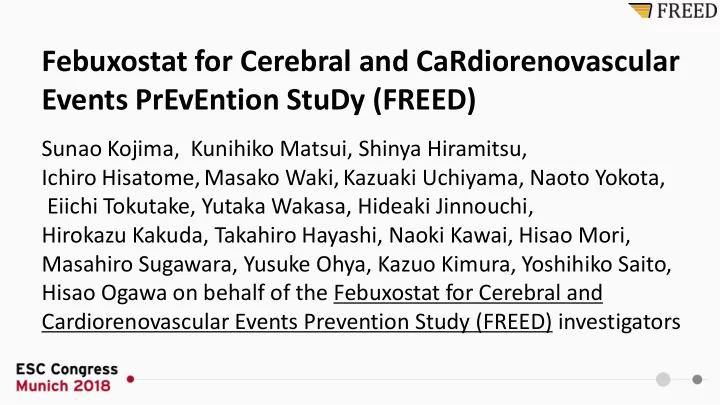

Febuxostat for Cerebral and CaRdiorenovascular Events PrEvEntion StuDy (FREED) Sunao Kojima, Kunihiko Matsui, Shinya Hiramitsu, Ichiro Hisatome, Masako Waki, Kazuaki Uchiyama, Naoto Yokota, Eiichi Tokutake, Yutaka Wakasa, Hideaki Jinnouchi, Hirokazu Kakuda, Takahiro Hayashi, Naoki Kawai, Hisao Mori, Masahiro Sugawara, Yusuke Ohya, Kazuo Kimura, Yoshihiko Saito, Hisao Ogawa on behalf of the Febuxostat for Cerebral and Cardiorenovascular Events Prevention Study (FREED) investigators
Conclusion Uric acid level lowering by febuxostat provides clinical benefit for prevention of cerebral, cardiovascular, and renal events in elderly patients with hyperuricemia. Febuxostat may be expected to prevent the development and progression of chronic kidney disease.
Background -1- Urate-lowering therapy with anti-hyperuricemic drugs can prevent the recurrence of urate deposition – related diseases. (Perez-Ruiz F et al. Arthritis Rheum 2002) Hyperuricemia may contribute to the development and progression of cerebrocardiovascular diseases and mortality. (Kojima S, et al. Am J Cardiol 2005) (Li M, et al. Sci Rep 2016) Febuxostat approved in 2011 in Japan has a more potent serum uric acid – lowering effect compared with that of allopurinol. (Kamatani N, et al. J Clin Rheumatol 2011)
Production and Metabolism of Uric Acid Adenosine Human Vascular Smooth Muscle Cells Inosine Febuxostat Hypoxanthine Allopurinol - ・ O 2 + Na + Xanthine Xanthine oxidoreductase - ・ O 2 + Oxypurinol URAT 1 anion - Uric acid (UA) UA Urate oxidase Excretion Allantoin Nature 2002;417:447-452 Renal (2/3) Benzbromarone Circulation 2003;107:1951-1953 Gastrointestinal (1/3) probenecid J Am Soc Nephrol 2006;17:1791-1795
Background -2- The Cardiovascular Safety of Febuxostat and Allopurinol in Patients with Gout and Cardiovascular Morbidities (CARES) trial revealed that all-cause mortality and cardiovascular mortality were higher with febuxostat treatment than with allopurinol treatment in gout patients with cardiovascular disease. (White WB, et al. N Engl J Med 2018) It remains to be elucidated whether the mortality results of the CARES trial are due to beneficial effects of allopurinol or deleterious effects of febuxostat. (Choi H, et al. Arthritis Rheumatol 2018)
Aim The Febuxostat for Cerebral and CaRdiorenovascular Events PrEvEntion StuDy (FREED) was conducted to compare the occurrence of cerebral, cardiovascular, and renal events in elderly patients with hyperuricemia at risk for cerebral or cardiorenovascular disease treated with febuxostat and those treated with conventional therapy.
Methods Design • Multicenter, prospective, randomized open-label, blinded end point (PROBE), two-arm parallel treatment groups study Subjects • Elderly patients aged 65 years or older with hyperuricemia (serum uric acid level >7.0 to ≤9.0 mg/dL) who had one or more risks for cerebral, cardiovascular, or renal disease a. History of active hypertension b. History of active type 2 diabetes mellitus c. Renal disorder (eGFR ≥30 to <60 mL/min/1.73 m 2 ) within 3 months prior to enrollment d. History of cerebrocardiovascular disease occurring >3 months prior to enrollment (Kojima S, et al. J Cardiol 2017;69:169-75)
Methods Non-febuxostat group Consider use of allopurinol 100 mg if serum uric acid is elevated Screening Study treatment continued up to Month 36 Informed Enrollment consent Randomization 40 mg Febuxostat group 20 mg Administer febuxostat 10 mg W0 W4 W8 W12 M6 (Investigation every 6 months) M36 Lifestyle modification for management of hyperuricemia in all patients (Kojima S, et al. J Cardiol 2017;69:169-75)
Results Changes in serum uric acid level 12 Febuxostat group Non-febuxostat group 10 mean ± SD Serum uric acid (mg/dL) 8 Non-febuxostat: 6.76 ± 1.45 mg/dL 6 Febuxostat: 4 4.50 ± 1.52 mg/dL * * * * * * * * * 2 * P<0.001 0 Time point of blood sample collection
Primary End Point (Composite of death due to any cause, cerebrovascular disease, non-fatal coronary artery disease, heart failure requiring hospitalization, arteriosclerotic disease requiring treatment, renal impairment, atrial fibrillation) Cumulative rate of the primary endpoint 0.4 Febuxostat group (n=537) Non-febuxostat group (n=533) 28.7% 0.3 Hazard ratio=0.750 (95% CI, 0.592-0.950, P=0.017 ) 0.2 23.3% 0.1 0 0 3 6 9 12 15 18 21 24 27 30 33 36 No. at risk Months Febuxostat 537 515 473 429 399 372 209 Non-febuxostat 533 501 451 391 370 341 188
Secondary End Point Febuxostat group Non-febuxostat Hazard ratio (95% P (n=537) group (n=533) confidence interval) value Death due to cerebral, cardiovascular and 6 (1.1) 6 (1.1) 0.958 (0.314-2.926) 0.940 renal disease Cerebrovascular disease 9 (1.7) 7 (1.3) 1.271 (0.479-3.371) 0.630 Non-fatal coronary artery disease 4 (0.7) 7 (1.3) 0.559 (0.167-1.869) 0.345 Heart failure requiring hospitalization 9 (1.7) 12 (2.3) 0.699 (0.290-1.689) 0.427 Arteriosclerotic disease requiring treatment 2 (0.4) 3 (0.6) 0.644 (0.107-3.873) 0.631 Renal impairment 87 (16.2) 109 (20.5) 0.745 (0.562-0.987) 0.041 Atrial fibrillation 4 (0.7) 3 (0.6) 1.320 (0.292-5.968) 0.719 Death due to other cause 4 (0.7) 6 (1.1) 0.635 (0.179-2.253) 0.482 Hard end point (composite of death due to any cause, cerebrovascular disease, or non- 23 (4.3) 26 (4.9) 0.861 (0.492-1.506) 0.600 fatal coronary artery disease)
Key messages • Febuxostat has greater renoprotective effect. However, cardiovascular protection may not be expected compared with renal protection. • Based on the results of both the CARES trial and our present study, treatment with febuxostat did not reduce major cerebrocardiovascular events.
Recommend
More recommend